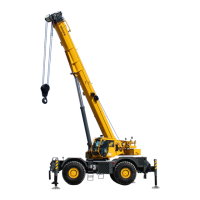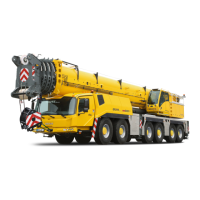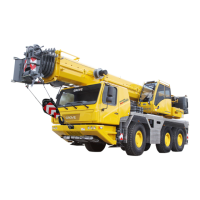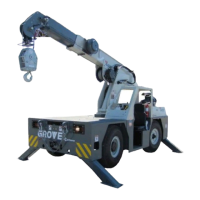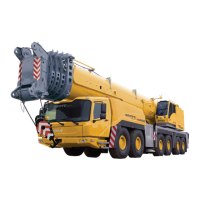Grove Published 01-29-2015, Control # 512-01 8-21
TMS700E SERVICE MANUAL UNDERCARRIAGE
WHEELS AND TIRES
Description
The following tire size is available for the axles:
• Front axle; size 445/65R22.5
• Rear axle: size 315/80R22.5.
NOTE: Tire diameter, width, and weight may vary slightly
depending upon the manufacturer.
Tires are designed to operate with a certain sidewall
deflection or bulge. Correct air pressures ensures proper
deflection which, in turn ensures proper traction, flotation,
support of load and prevents excessive flexing of the tire.
Overinflation increases rim stresses which results in lower
rim life.
Inflate tires to the pressure specified on the tire inflation
decal on the crane.
Unmatched tires on either tandems will cause wear, scuffing,
and possible damage to drive units. It is recommended that
tires be matched to within 3.2 mm (0.13 in) of the same
rolling radius and 19.0 mm (0.75 in) of the same rolling
circumference.
In addition to matching individual tire rolling radii and
circumference, the total tire circumference of one driving axle
should match the other driving axle.The result will be
satisfactory axle lubricant temperatures.
Maintenance
Mounting the Wheels on the Front Axle
NOTE: Do not lubricate the wheel studs or lug nuts or the
wheel face or the hub. On aluminum wheels,
lubricate the wheel pilot or hub pads only with an
antiseize compound or synthetic lubricant with
teflon. Do not lubricate wheel or hub faces.
1. Raise the crane on outriggers so the front wheels are off
the ground.
2. Generously coat the wheel pilot or hub pads with
antiseize compound. Do not apply antiseize compound
to the face of the wheel or the hub.
3. Place the wheel assembly on the mounting studs. Take
care not to damage the studs.
4. Install hub cover if applicable.
5. Install the lug nuts and tighten them until they are just
snug. Rotate the wheel while installing each nut so the
nut being tightened is in the top position. Do not lubricate
the nuts or studs.
6. Tighten the lug nuts in the sequence shown to a
preliminary torque of 68 Nm (50 lb-ft) (see Figure 8-13).
7. Keep tightening the lug nuts in the sequence shown until
all 10 are torqued to 610 to 678 Nm (450 to 500 lb-ft)
(see Figure 8-13).
8. Install lug nut covers on lug nuts.
9. Lower the crane onto its tires. Retract and stow the
outrigger assemblies and the floats.
10. Road-test the tire, then retorque to 610 to 678 Nm (450
to 500 lb-ft).
Maintain proper torque on wheel lugs and check for proper
wheel mounting. Retorque the lug nuts 80 to 160 km (50 to
100 miles) after the wheels are removed and reinstalled. This
will reseat the lug nuts. Check the torque every 800 km
(500 miles) thereafter.
CAUTION
Do not mix tires or rims from different manufacturers.
CAUTION
Do not install the largest tires on one driving axle and the
smallest on the other driving axle. This will cause axle
“fight” and high lubricant temperatures resulting in
premature lubricant breakdown and costly axle service.
DANGER
Do not dismount or mount tires on rims without proper
training. High pressures can cause tire and rim parts to fly
apart with explosive force and cause injury or death.
Reference Only
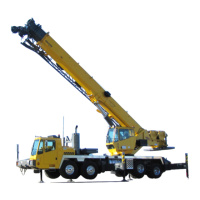
